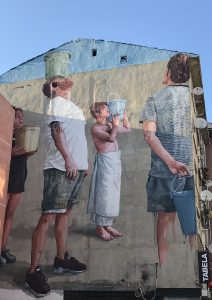“The Judge’s Village”
Old name: Chalcedon
The great divide in İstanbul created by the Bosphorus strait means that relatively few foreign visitors make it over to the Asian side of the city although the Marmaray rail link has made it easier and quicker to do so than it used to be. Those who do make it over discover is a vibrant suburb with a left-wing student vibe and an excellent central market full of tempting culinary titbits. With no great sights to see here you can just relax, browse the pedestrianised market and enjoy the restaurants, including the famous Çiya, renowned as a gourmet stronghold.
If you prefer a focus for your wandering, a few minor sights lurk within walking distance of the ferry terminals. Both Kadife Sokak (Barlar Sokak) and Bahariye Caddesi, the İstiklal Caddesi of the Asian side of town, are perfect places for people-watching.
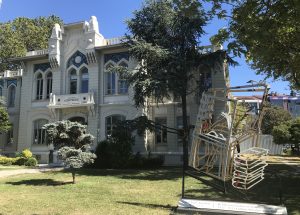
Around Kadıköy
When you step off the ferry at Kadıköy you will find yourself facing a low-slung building that houses the İstanbul Conservatoire. It was originally built in the 1920s as a market hall and is currently being completely made over. It forms a set-piece with two other examples of First National architecture nearby: the original ferry terminal just along the promenade and the Kadıköy Kayamakamlığı building, designed in 1913 by Constantinos Kyriakides and now housing a library – it’s just inland behind the statue of Atatürk teaching children the new Turkish alphabet that was introduced to replace the Ottoman one in 1928.
If you cross the busy coast road and head up Söğütlüçeşme Caddesi you will have the labyrinth of narrow pedestrianised shopping streets around the market on your right. Keep walking uphill though and you will come to Kadıköy’s most famous landmark, the Boğa Heykeli (Bull Monument) behind which lies an unexpectedly fascinating story. 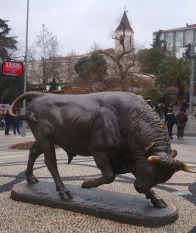
In 1867 Sultan Abdülaziz was the first Ottoman ruler to visit Europe for pleasure; the carriage in which he did so is preserved in the Rahmi M. Koç Museum in Hasköy. Having admired the statues he saw around the continent, he returned to Constantinople and commissioned not just a bust of himself that is now in Topkapı Palace but also 24 statues of animals in bronze or marble by the French artist Pierre Louis Rouillard (1820-81). Most of them ended up in Beylerbeyi Palace while a couple still grace the lawn of the Dolmabahçe Palace. The horse in the upper garden of the Sakıp Sabancı Museum in Emirgan comes from the same horde, as is the bull. I wonder how many of the people who scramble onto the back of the bull at the start of Bahariye Caddesi ever pause to consider that they are climbing onto a monument that is more than 100 years old?
If you turn right at the bull you will find yourself walking along Asım Gündüz Caddesi, known to all and sundry as Bahariye Caddesi. As on İstiklal Caddesi a nostalgic tram trundles along the street if you don’t feel like walking.
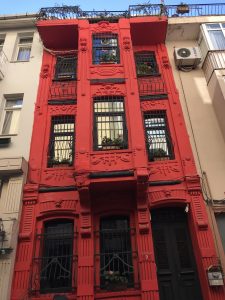 On the left is the square tower of the Church of Surp Levon, built in 1911 and the only Armenian Catholic church in the Asian side of the city (on the European side there is another Armenian Catholic church in Karaköy).
On the left is the square tower of the Church of Surp Levon, built in 1911 and the only Armenian Catholic church in the Asian side of the city (on the European side there is another Armenian Catholic church in Karaköy).
A little way along Bahariye Caddesi a turning on the left leads down to the Nazım Hikmet Cultural Centre, its shady courtyard a popular hangout for students.
The main sight on Bahariye Caddesi is the elegant Sürreya Opera House, built in 1924 and long used as a cinema. Although it was turned back into an opera house in 2007 its interior is still that of a cinema of the Golden Age – you can almost imagine the Wurlitzer rising up from the floor. Nearby one shattered piece of brick wall is all that remains of the 19th-century Köceoğlu Hamam, named after Agop Köçeyan, bookseller to the sultans.
If instead of heading up Söğütlüçeşme Caddesi you plunge into Kadıköy’s market streets you will come across two vaguely old but hardly exciting mosques: the 17th-century Osman Ağa Cami and the İskele Cami (Harbour Mosque), facing the water, that was built in 1760 but had to be entirely rebuilt in 1858.
Buried in the market are two 19th-century churches. The first, the Greek Orthodox Church of St Euphemia, overlooks a small square which used to be marked with a statue of a tiny crocodile, a reminder of the Amasya-born geographer Strabo’s suggestion that the locals used to feed the crocodiles living in a stream here (it’s whereabouts are unknown since the square was relaid). St Euphemia is believed to have lived in Byzantine Chalcedon where she was thrown to a bear for refusing to recant her Christianity. The church is an 1830 rebuild of a 1794 original.
Nearby is the 19th-century Armenian Orthodox Church of Surp Takavor (Christ the King).
The Kadıköy church you are most likely to be able to see inside is the huge Greek Orthodox Church of Hagia Triada (Holy Trinity), dating back to 1902 and set in a sizeable garden near Barlar Sokak.
The back streets of Kadıköy feature some fine wooden houses in varying states of repair as well as some terraced stone houses such as the ones in Barlar Sokak. Until recently the small streets leading inland from the coast road were mainly in a fairly poor condition but gentrification is seeing them being steadily renovated.
Eating and drinking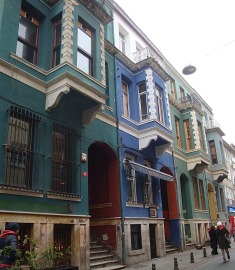 Kadife (Barlar) Sokak
Kadife (Barlar) Sokak
Barlar Sokak with its themed house-bars used to be the cool place to hang out but these days much of the night-time action seems to have moved into the streets around the market stalls, no doubt because there’s more space in which to spread out there.
Baylan In summer when thoughts fly to an ice-cream sundae where could be better than this long-lived (1961) cake shop which has a back “garden” where you can linger over the house specialty, a Küp Griye, or caramel sundae. Muvakkithane Caddesi No. 19, Tel: 0216-336 2881
Çiya A temple to Turkish cuisine especially of the southeastern variety, Çiya is spread across three buildings in the same street which means that you should be able to find a seat even at busy times of year. Most people rave about it. My own experiences there have tended to be quite mundane. , Güneşlibahçe Sokak, Tel: 0216-418 5115
Küp Café One of Turkey’s many saklı bahçes (hidden gardens) lurks behind the low-key façade of this café. Come here to down a drink with the locals amid tall shady trees in the heat of summer. Güneşlibahçe Sokak No. 47, Tel: 0216-347 8694
Sleeping
DoubleTree by Hilton This unmissable high-rise hotel at the start of the road to Moda offers spectacular views from its 245-deluxe rooms although its surroundings are none too inspiring. Facilities include indoor and outdoor pools, and several restaurants. Albay Faik Özdener Caddesi No. 31, Tel: 0216-542 4344
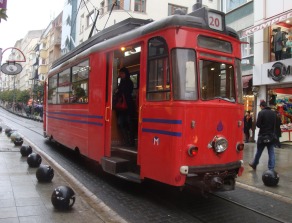 Transport info
Transport info
By far the best way to get to Kadıkoy is on one of the ferries that leave from Eminönü, Karaköy, Kabataş and Beşiktaş.
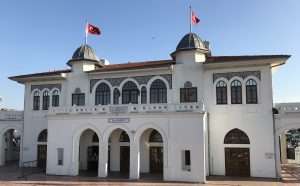
The ferries stop running relatively early (around 8pm) in which case you can hop a dolmuş to Üsküdar and get the Marmaray back to the European side. Alternatively you can take the Metro which runs from Kadıköy to Kartal to Ayrılıkçeşmesi (one stop) and change there to the Marmaray. If you take a dolmuş direct to Taksim it will be more expensive than usual as it will cross one of the Bosphorus bridges and incur a toll for doing so.
There’s a sprawling bus terminal on the waterfront just west of the ferry terminal. Most dolmuşes leave from a parking place a short walk east of the terminal although some heading up the Bosphorus leave from the far side of the main coast road. They’re a good way to get around with a guaranteed seat although some are driven alarmingly fast.
The nostalgic tram that runs round Kadıköy and the edge of Moda is not very practical but can be fun and is worth knowing about if you’d rather not walk far.
Nearby areas
